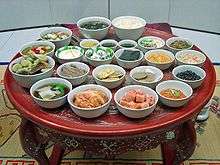Mandu (dumpling)
 | |
| Type | Dumpling |
|---|---|
| Place of origin |
Goryeo Dynasty (now Korea) |
|
| |
| Mandu | |
| Hangul | 만두 |
|---|---|
| Hanja | 饅頭 |
| Revised Romanization | mandu |
| McCune–Reischauer | mandu |
 |
| This article is part of a series on |
| Korean cuisine 한국 요리 조선 료리 |
|---|
|
Staples |
|
|
Mandu are dumplings in Korean cuisine. They are similar to pelmeni and pierogi in some Slavic cultures. The name is cognate with the names of similar types of meat-filled dumplings along the Silk Road in Central Asia, such as Turkish manti, and Kazakh manty. Chinese mantou is also considered a cognate, which used to mean meat-filled dumplings, but now refers to steamed buns without any filling.[1][2][3]
In Korean cuisine, mandu generally denotes a type of filled dumpling similar to the Mongolian buuz and Turkish mantı, and some variations are similar to the Chinese jiaozi and the Japanese gyoza. If the dumplings are grilled or fried, they are called gunmandu (군만두); when steamed, jjinmandu (찐만두); and when boiled, mulmandu (물만두).[4]
Mandu are usually served with kimchi, and a dipping sauce made of soy sauce, vinegar and chilli. They are often filled with minced meat, tofu, green onions, garlic and ginger.[5]
History
Mandu are believed to have been first brought to Korea by Mongolians in the 14th century during the Goryeo Dynasty.[6] The state religion of Goryeo was Buddhism, which discouraged consumption of meat. Mongolian incursion into Goryeo relaxed the religious prohibition against consuming meat, and mandu was among the newly imported dishes that included meat.
Another possibility is mandu came to Korea at a much earlier period from the Middle East through the Silk Road. Historians point out many cuisines based on wheat, such as dumplings and noodles originated from Mesopotamia and gradually spread from there. It also spread east along the Silk Road, leaving many versions of mandu throughout Central and East Asia.[7]
Varieties
- Mulmandu (물만두), the word itself means "water mandu" since it is boiled.[8]
- Gunmandu (군만두) is pan-fried mandu, it's derived from guun-mandu 구운만두=>군만두 to mean "panned" dumplings. It's sometimes called by its Japanese name, yakimandu.[9][10]
- Jjinmandu (찐만두) is steamed, either in a traditional bamboo steamer or modern versions.[6]
- Gullin mandu (굴린만두), or called gulmandu is a variety of mandu in a ball shape without a covering. It is mainly eaten in summer.[11]
- Wang mandu (왕만두), is a bun stuffed with pork and vegetables, similar to the Chinese baozi.
- Pyeonsu (편수), mandu stuffed with vegetables in a rectangular shape. It is mainly eaten in summer and a local specialty of Kaesong, North Korea.[12]
- Eomandu (어만두), mandu wrapped with sliced fish fillet. It was originally eaten in Korean royal court and yangban (noble class) families.[13]
- Saengchi mandu (생치만두), mandu stuffed with pheasant meat, beef, and tofu, that was eaten in Korean royal court and in the Seoul area during winter.[14]
- Seognyu mandu (석류만두), literally "pomegranate dumpling" because of the shape [15]
- Somandu (소만두), mandu stuffed with only vegetables, that was originally eaten in Buddhist temples.[16]
- Gyuasang (규아상), mandu stuffed with shredded cucumber and minced beef in the shape of sea cucumber. It is mainly eaten in summer.[17][18]
- Kimchi mandu (김치만두), the stuffing contains kimchi. The addition of kimchi gives it a spicier taste compared to other mandu.[19]
Dishes made with mandu
Manduguk is a variety of Korean soup (guk) made with mandu in beef broth. In the Korean royal court, the dish was called byeongsi (餠匙) while in Eumsik dimibang, a 17th-century cookbook, it was called "seokryutang" (석류탕).[20]
In popular culture
- In the 2003 South Korean film Oldboy, the protagonist Oh Dae-Su is fed a steady diet of fried mandu, the food that he detests the most, while he is imprisoned. After he is released, he visits various restaurants serving the dish to get clues and determine where he was held captive.[21]
- Wonder Girls' member, Ahn Sohee, is often referred to as Mandu due to her cheeks resembling the shape of mandu.[22]
See also
References
- ↑ Anderson, E.N. (2005). Everyone Eats: Understanding Food and Culture. NYU Press. p. 294.
- ↑ Millward, James (2013). The Silk Road: A Very Short Introduction. Oxford University Press. p. 76.
- ↑ Davidson, Alan (2006). The Oxford Companion to Food. OUP Oxford. p. 480.
- ↑ Favorite foods, Korean Tourism Organization
- ↑ Goldberg, Lina "Asia's 10 greatest street food cities" CNN Go. 23 March 2012. Retrieved 2012-04-11
- 1 2 (Korean) Mandu at Doosan Encyclopedia
- ↑ (Korean) Mandu, Hankook Ilbo, 2009-01-21
- ↑ (Korean) Mulmandu recipe, Naver kitchen
- ↑ (Korean) Gunmandu, Naver dictionary
- ↑ (Korean) Yakimandu, Naver dictionary
- ↑ (Korean) Gullin mandu at Encyclopedia of Korean Culture
- ↑ (Korean) Pyeonsu at Encyclopedia of Korean Culture
- ↑ (Korean) Eomandu at Encyclopedia of Korean Culture
- ↑ (Korean) Saengchi mandu at Encyclopedia of Korean Culture
- ↑ (Korean) The three aesthetics of mandu, Lee Mi-jong (이미종), Yeoseong Chosun, 2008-02-14.
- ↑ (Korean) Somandu at Encyclopedia of Korean Culture
- ↑ (Korean) Gyuasang at Encyclopedia of Korean Culture
- ↑ (Korean) Gyuasang at Doosan Encyclopedia
- ↑ (Korean) Kimchi mandu at Doosan Encyclopedia
- ↑ (Korean) Manduguk at Encyclopedia of Korean Culture
- ↑ (Korean) Old Boy mandu, Yonhap News, 2005-03-21
- ↑ (Korean) Sohee hates nickname Mandu, Joy News 24, 2008-01-14
External links
- Golden Mandu (Korean Dumplings) (Kate's Global Kitchen, by Kate Heyhoe)
- Traditional Mandu Recipe, Korean-Cooking.com
